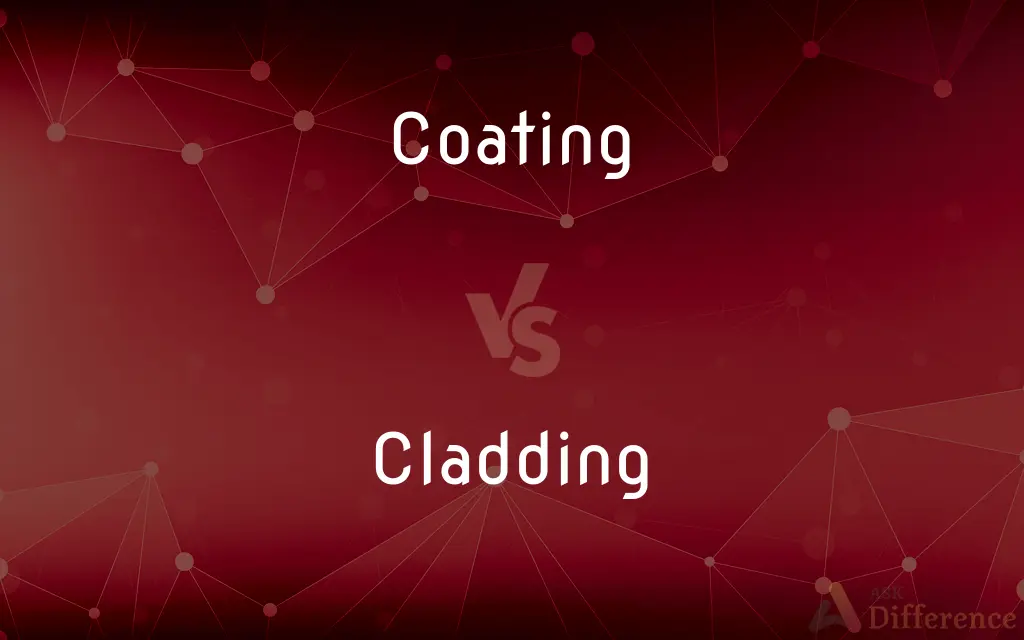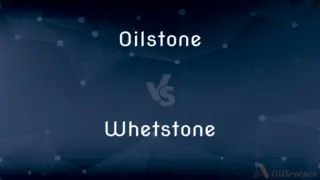Coating vs. Cladding — What's the Difference?
By Tayyaba Rehman — Updated on December 30, 2023
Coating involves applying a layer, often for protection or aesthetics, to a surface. Cladding is the application of one material over another to provide a skin or layer for insulation or aesthetic purposes.

Difference Between Coating and Cladding
Table of Contents
ADVERTISEMENT
Key Differences
Coating refers to covering an object or surface with a paint, varnish, or other substances to protect or decorate it. Cladding, however, involves the application of one material over another to provide a protective or insulating layer.
A coating is usually a thin layer applied to the surface of an object. Cladding is typically a more substantial, often structural layer added to the exterior of a building or other object.
Coatings are often used to provide resistance against corrosion, wear, and tear. Cladding is used not only for protection but also to improve the appearance of a building or structure.
The process of applying a coating can be as simple as painting or spraying. In contrast, cladding involves physically attaching another layer, often requiring more complex construction techniques.
Coating materials can include paints, lacquers, and varnishes. Cladding materials, however, are more diverse, including metal, wood, stone, or composite materials.
ADVERTISEMENT
Comparison Chart
Definition
Applying a layer for protection or aesthetics
Applying a material for insulation or aesthetics
Thickness
Usually thin
Can be thick and substantial
Purpose
Mainly protection and decoration
Protection, insulation, and aesthetic enhancement
Application Process
Painting, spraying
Physical attachment, construction
Materials Used
Paints, varnishes
Metal, wood, stone, composites
Compare with Definitions
Coating
A film or covering applied to an object.
The new car had a clear coating to protect its paint.
Cladding
The application of one material over another to provide a skin or layer.
The building was clad in stainless steel.
Coating
A process of applying a protective or decorative layer.
He specialized in coating technology for industrial applications.
Cladding
A material used as an exterior layer for insulation or appearance.
Wooden cladding was chosen for its natural look.
Coating
A coating is a covering that is applied to the surface of an object, usually referred to as the substrate. The purpose of applying the coating may be decorative, functional, or both.Paints and lacquers are coatings that mostly have dual uses of protecting the substrate and being decorative, although some artists paints are only for decoration, and the paint on large industrial pipes is presumably only for the function of preventing corrosion.
Cladding
The process of adding an outer layer to a building for protection.
They are considering cladding the old warehouse in brick.
Coating
A layer of substance applied to a surface for protection or decoration.
The wooden deck was given a waterproof coating.
Cladding
Covering the exterior of a building with a particular material.
The new office block had glass cladding.
Coating
A covering that serves as a surface finish.
The fabric has a coating to make it water-resistant.
Cladding
A layer of material applied to the outside of a structure.
The cladding on the house provided extra thermal insulation.
Coating
A layer of a substance spread over a surface as for protection or decoration; a covering layer.
Cladding
A metal coating bonded onto another metal under high pressure and temperature.
Coating
Cloth for making coats.
Cladding
The process of forming such a coating.
Coating
A thin outer layer.
They painted on a coating to protect it from the weather.
Cladding
A protective or insulating layer fixed to the outside of a building or another structure.
Coating
(archaic) Cloth for making coats.
Cladding
(rare) Clothing; clothes.
Coating
A telling-off; a reprimand.
Cladding
Any hard coating, bonded onto the outside of something to add protection, such as the plastic sheath around an optical fibre.
Coating
Present participle of coat
We spent hours coating the truffles with cocoa powder so they wouldn't be sticky.
Cladding
(construction) A weatherproof, insulating or decorative covering fixed to the outside of a building.
Coating
A coat or covering; a layer of any substance, as a cover or protection; as, the coating of a retort or vial.
Cladding
Present participle of clad
Coating
Cloth for coats; as, an assortment of coatings.
Cladding
A protective covering that protects the outside of a building
Coating
A thin layer covering something;
A second coat of paint
Coating
A decorative texture or appearance of a surface (or the substance that gives it that appearance);
The boat had a metallic finish
He applied a coat of a clear finish
When the finish is too thin it is difficult to apply evenly
Coating
A heavy fabric suitable for coats
Coating
The work of applying something;
The doctor prescribed a topical application of iodine
A complete bleach requires several applications
The surface was ready for a coating of paint
Coating
Application of a liquid or powder to a surface.
The metal parts were sent for a protective powder coating.
Common Curiosities
Do coatings always change the color of a surface?
Not always, some coatings are clear and do not alter the color.
Are coatings used in industrial settings?
Yes, industrial coatings are common for corrosion protection and durability.
Is cladding considered a structural component?
It can be, especially in modern architectural designs.
Can cladding be purely decorative?
Yes, cladding can be used solely for enhancing the appearance of a building.
Are all coatings waterproof?
Many are designed to be waterproof, but not all coatings have this property.
Are coatings environmentally friendly?
It varies. There are eco-friendly coating options available.
Can cladding improve a building's insulation?
Yes, cladding can significantly enhance thermal insulation.
Is coating only used for protection?
Primarily, but it's also used for aesthetic purposes.
Is cladding used in residential construction?
Yes, cladding is widely used in both residential and commercial construction.
Can cladding be fire-resistant?
Yes, certain materials used in cladding can be fire-resistant.
Does cladding require maintenance?
Yes, different types of cladding require varying levels of maintenance.
Do coatings need to be reapplied periodically?
Yes, coatings may wear over time and require reapplication.
Can coatings be applied to any surface?
Most surfaces can be coated, but the suitability depends on the material and the type of coating.
Can coating be done as a DIY project?
Yes, simple coating projects can be done DIY, but professional application is recommended for best results.
Is cladding expensive?
The cost varies based on material and design complexity.
Share Your Discovery

Previous Comparison
Oilstone vs. Whetstone
Next Comparison
Patellar vs. PatellaAuthor Spotlight
Written by
Tayyaba RehmanTayyaba Rehman is a distinguished writer, currently serving as a primary contributor to askdifference.com. As a researcher in semantics and etymology, Tayyaba's passion for the complexity of languages and their distinctions has found a perfect home on the platform. Tayyaba delves into the intricacies of language, distinguishing between commonly confused words and phrases, thereby providing clarity for readers worldwide.
















































